
The Leyland LB buses for London Bus Companies
This page created 9th January 2020 using Wordpad, by Ian Smith.
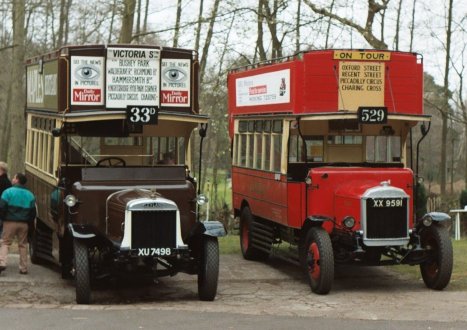 London in the 1920s was fertile ground for independent bus-men to start their own bus companies to compete with the General.
At first they only had to satisfy the Metropolitan Police that their buses were suitable.
The Police laid down stringent conditions relating to length, width, weight, power, lack of windscreens for drivers and design of staircases.
Leyland Motors designed a chassis that would meet the chassis requirements: the London Bus or LB.
Most received bodies by Dodson, who held a strongly General-independent policy.
The design was traditional, with normal control behind a long radiator,
and a 26 up, 22 down open-top body with open staircase. It had a high floor, of course.
It was an elegant machine, much better looking than the General's new K-type.
London in the 1920s was fertile ground for independent bus-men to start their own bus companies to compete with the General.
At first they only had to satisfy the Metropolitan Police that their buses were suitable.
The Police laid down stringent conditions relating to length, width, weight, power, lack of windscreens for drivers and design of staircases.
Leyland Motors designed a chassis that would meet the chassis requirements: the London Bus or LB.
Most received bodies by Dodson, who held a strongly General-independent policy.
The design was traditional, with normal control behind a long radiator,
and a 26 up, 22 down open-top body with open staircase. It had a high floor, of course.
It was an elegant machine, much better looking than the General's new K-type.
Two of the most popular 1920s buys for Independent bus operators: the Leyland LB and the Dennis 4-ton, in preservation at Cobham Bus Museum's Open Day in 2003.Chocolate Express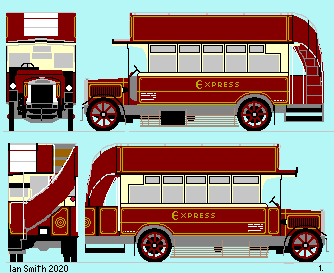 The company that really set the ball rolling was The Chocolate Express Bus Company, who bought a Leyland LB1 in July 1922.
After inspection by the Police (possibly by my grandfather!) minor adjustments were made and it went into service on route 11 (Liverpool Street - Victoria - Hammersmith).
The livery was chocolate and primrose, immaculately lined out in gold, with the fleetname "Express". The public loved it. It was taken into the public imagination as the Chocolate Express.
The LGOC did NOT love it. They tried all sorts of blocking tactics - all the malpractices that they later accused the "pirates" of employing: blocking, front and rear tailing.
This was noted by the Daily Herald newspaper, which launched a campaign. That, with public sympathy for the Chocolate Express, quickly led to the withdrawal of the chasers.
There were, after all, plenty of passengers to carry, and still too few buses.
The company that really set the ball rolling was The Chocolate Express Bus Company, who bought a Leyland LB1 in July 1922.
After inspection by the Police (possibly by my grandfather!) minor adjustments were made and it went into service on route 11 (Liverpool Street - Victoria - Hammersmith).
The livery was chocolate and primrose, immaculately lined out in gold, with the fleetname "Express". The public loved it. It was taken into the public imagination as the Chocolate Express.
The LGOC did NOT love it. They tried all sorts of blocking tactics - all the malpractices that they later accused the "pirates" of employing: blocking, front and rear tailing.
This was noted by the Daily Herald newspaper, which launched a campaign. That, with public sympathy for the Chocolate Express, quickly led to the withdrawal of the chasers.
There were, after all, plenty of passengers to carry, and still too few buses.
Other Independents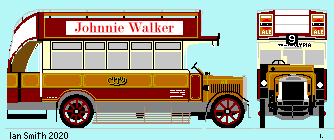 Other independent operators followed on inner-London routes, some using older types, others new Dennis 4-ton buses, some Straker-Squires, quite a few with new Leyland LB types.
Other independent operators followed on inner-London routes, some using older types, others new Dennis 4-ton buses, some Straker-Squires, quite a few with new Leyland LB types.
By the end of 1922 there were six Independent bus companies operating in Central London, but by the end of 1923 there were 75, and by the end of 1924 180 companies were operating, with about 600 buses. In General's mind something had to be done. They had friends in high places who were persuaded that the anarchy of so many small operators challenging the Big Brother of the General was a BAD THING, and a
The London Traffic Act, 1924 The powers that be brought the anarchy to a halt in August 1924.
Now operators had to give notice of their intended routes and schedules during Monday to Saturday. On Sundays operators could operate where they liked, according to weather and events. They had to display fare tables where the travelling public could see them. Not only that, but certain roads were restricted, with only a limited number of buses allowed. The independent operators thought, with some justification, that its application was heavily weighted in favour of the "Combine" - the General. The number of registered short routes became enormous, much to the dismay of Chief Constable Bassom. There was a new route numbering system, applied from April 1925, with a separate route number or suffix for each working. It was cumbersome, and in many ways daft (even if a version of it was still working in Birmingham in the 1970s).
The powers that be brought the anarchy to a halt in August 1924.
Now operators had to give notice of their intended routes and schedules during Monday to Saturday. On Sundays operators could operate where they liked, according to weather and events. They had to display fare tables where the travelling public could see them. Not only that, but certain roads were restricted, with only a limited number of buses allowed. The independent operators thought, with some justification, that its application was heavily weighted in favour of the "Combine" - the General. The number of registered short routes became enormous, much to the dismay of Chief Constable Bassom. There was a new route numbering system, applied from April 1925, with a separate route number or suffix for each working. It was cumbersome, and in many ways daft (even if a version of it was still working in Birmingham in the 1970s).
LGOC, Public, Overground and the AssociationsSome Independents threw in the towel, and sold up to the General, which was prepared to pay a good price - not so much for the buses as for the schedules that came with them. These bought buses had to stay nominally with their owning company, which had sold out to the General. At first they retained their own liveries, but with the LGOC legal lettering, but at repaints/overhauls they donned red and off-white. In 1928 the rules were relaxed and the companies were dissolved, the buses now legally belonging to the LGOC.Many small operators were reluctant to sell to the General, but were finding the going hard, being kept off the most lucrative routes by Restricted Roads orders. Many were enticed to sell up to Public, which masqueraded as Independent, but paid roughly twice as much as the General for a bus and its schedules. It was eventually unmasked as an agent for the General, and was subsumed by the LGOC in December 1928. Other operatorss formed Associations, working specific routes and using their combined strength to exert pressure on the system. These, including Chocolate Express, Birch and City mainly wore brown and cream to proudly didstinguish themselves from the General. Two of the West London Association's major routes were the 526 and the 536. The East London Association operated the 511 and 525. The North London Association jointly worked the 284A. Other looser groupings worked other routes, including the 263, 291, 292 and the 551. Others continued to compete with the General on "their" routes, despite the limitations imposed by the Restricted Roads regulations. Several of the Associations broke up after members were targeted by Public. Carlton sold up to the LGOC, and continued to operate the routes out to Potters Bar as the Overground, with a sizeable fleet including thirteen LBs.
NationalIden at National was pestering Pick at LGOC for more buses in mid-1927, to counter increasing competition along the Lea Valley and in Hertfordshire. Pick used the influx of Leyland LBs from taken-over Independents to send nine of them north. They were better than nothing, and better for the area than the underpowered and slow PS-types. But they still had the speed-limiting solid tyres, and Hertfordshire was a county of open roads, not congested streets. So they only lasted with National until 1928, when National withdrew them for scrap as sleeker, faster buses arrived.
London TransportBut London Transport had little use for these buses, which now looked very antiquated alongside the Titans and the new Regents. Then some found new homes in the service vehicle fleet. Seven became tower wagons for servicing overhead wiring for the tramway system, and put in a further eleven years service. Three became lorries in the service fleet, two of these also putting in another eleven years. One oddity was a petrol tanker that had been converted from a LB bus by City, but this did not last long with LT.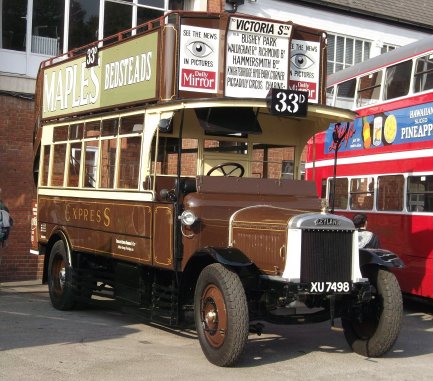
PreservationBy great fortune, the last of the Chocolate Express buses, taken over by London Transport, was sold for farm use. It was discovered, somewhat derelict, fifty years later on a farm in Norfolk. It was acquired and lovingly restored by Mike Sutcliffe to pristine condition, with pneumatic tyres. It is now resident at the London Bus Museum at Brooklands.Beautifully preserved by Mike Sutcliffe, Chocolate Express Leyland LB4 XU7498 on display at the London Bus Museum, Brooklands, at the Museum's formal opening in October 2011. |
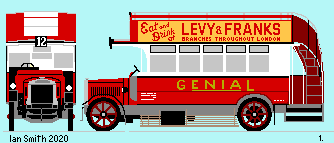 danger to the public (who had already benefitted from LGOC having to reduce its fares and by there being many more buses to choose from. Not that all the Independent operators were scrupulous. Many buses were painted to look like General buses, and once aboard the passenger had to pay what was asked! One LB4 even had a fleet name of "Genial", until legal action stopped it.
But many of the operators were reputable and developed sizeable fleets. Chocolate Express bought more LBs. City Motor Omnibus bought twenty-two.
Carlton bought eight. Enterprise had five eventually.
The LB was evolving, from the LB1 through to the LB5, with improved turning circle, allowing it to operate more routes.
danger to the public (who had already benefitted from LGOC having to reduce its fares and by there being many more buses to choose from. Not that all the Independent operators were scrupulous. Many buses were painted to look like General buses, and once aboard the passenger had to pay what was asked! One LB4 even had a fleet name of "Genial", until legal action stopped it.
But many of the operators were reputable and developed sizeable fleets. Chocolate Express bought more LBs. City Motor Omnibus bought twenty-two.
Carlton bought eight. Enterprise had five eventually.
The LB was evolving, from the LB1 through to the LB5, with improved turning circle, allowing it to operate more routes.
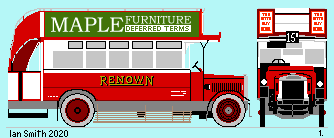 It seemed that the days of the LB series had come to an end in 1927, when its production was superceded by the new Leyland Titan, which rapidly became the Independent bus of choice. But many of the LBs soldiered on
through the rest of the twenties, some in sizeable fleets such as City.
Some lasted through to acquisition by London Transport in 1933/4,
even one of the Chocolate Express buses that had been used for some time as a spare alongside their Titans.
One of the City buses had been given a longer life by being converted to semi-forward control,
which allow the fitting of a higher capacity saloon and top-deck, so that it now seated 55, comparable with the NS.
Most, but not all, survivors had received pneumatic tyres in about 1928, the allowable maximun speed being then raised from 12mph to 20mph, a significant benefit in road capacity!
It seemed that the days of the LB series had come to an end in 1927, when its production was superceded by the new Leyland Titan, which rapidly became the Independent bus of choice. But many of the LBs soldiered on
through the rest of the twenties, some in sizeable fleets such as City.
Some lasted through to acquisition by London Transport in 1933/4,
even one of the Chocolate Express buses that had been used for some time as a spare alongside their Titans.
One of the City buses had been given a longer life by being converted to semi-forward control,
which allow the fitting of a higher capacity saloon and top-deck, so that it now seated 55, comparable with the NS.
Most, but not all, survivors had received pneumatic tyres in about 1928, the allowable maximun speed being then raised from 12mph to 20mph, a significant benefit in road capacity!
 Ian's Bus Stop
Ian's Bus Stop LB main text.
LB main text. LB histories
LB histories